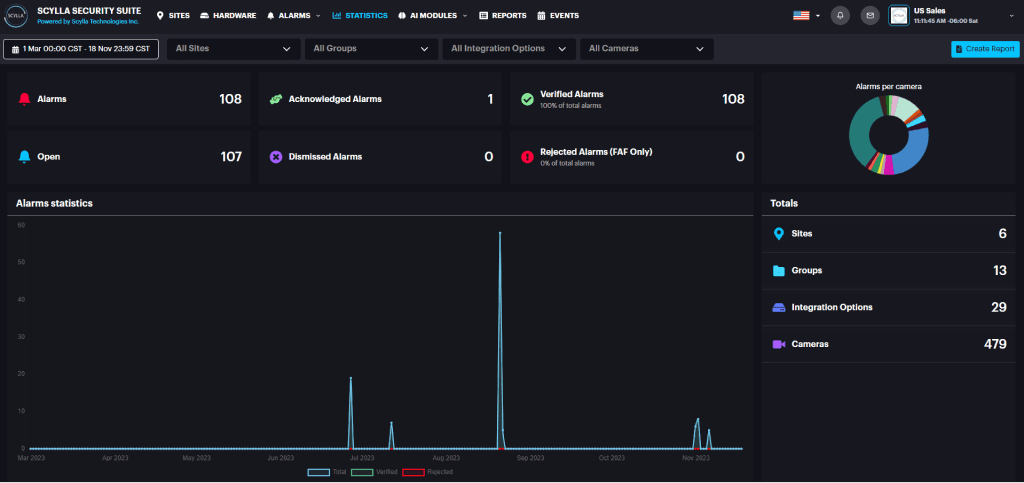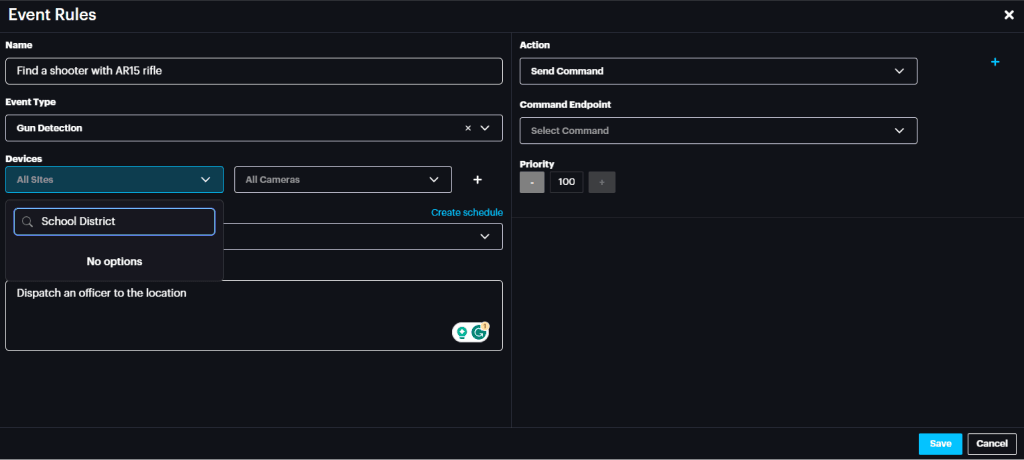
How to Mitigate Active Shooter Threats

Albert Stepanyan
President and CEO at Scylla AI
Active shooter incidents are a stark reality in today's world, with traditional mitigation techniques often falling short in the face of such unpredictable and rapidly evolving threats. The "Run, Hide, Fight" protocol, as outlined by the Office of Public Safety at St. Mary's College of Maryland, provides a basic framework for individual responses to active shooter situations. However, the protocol alone may not be sufficient to address the complexity and variability of active shooter scenarios. So, let’s take a closer look at a comprehensive approach to active shooter mitigation and explore the role of advanced technologies in enhancing prevention, preparedness, and response to active shooter situations.
Understanding the "Run, Hide, Fight" protocol
The "Run, Hide, Fight" protocol advises individuals to evacuate if possible, hide silently and securely if escape is not feasible, and, as a last resort, fight to disrupt or incapacitate the shooter. While this guidance is valuable, it is primarily reactive and focuses on individual actions rather than organizational preparedness.
The "Run, Hide, Fight" strategy flaws
● Fails to address the 'Freeze' response
One of the significant limitations of this strategy is its failure to address the 'freeze' response, a common human reaction to sudden and unexpected violence. People often freeze momentarily in such scenarios, especially if they lack the mental conditioning and physical skills to deal with violence. This can lead to panic-induced paralysis, leaving potential victims unprepared for the reality of an attack.
● Linear thinking does not always work
The "Run, Hide, Fight" model assumes that victims will progress through the steps in a linear order, which is not always practical or safe. There are situations where fighting could be a safer initial response than running or hiding. This linear approach can be detrimental in dynamic situations where immediate action might be necessary.
● Fosters a non-aggressive mindset
By emphasizing running and hiding as principal options, this model can foster a nonaggressive mindset, potentially leaving individuals unprepared to fight back when necessary. This approach can contribute to a victim mindset, where people might not consider defending themselves as a viable option.
● Individualistic focus of the response process
The strategy largely focuses on individual actions rather than a coordinated effort. In a real-life scenario, it's important for individuals to have different responsibilities to maximize safety. For instance, those who can escape should immediately contact authorities to assist others still in danger.
● Lack of flexibility in a variety of situations
Critics argue that each step - Run, Hide, Fight - has its flaws. Running might lead one into harm's way or could cause injury, making one an easier target. Hiding could leave one vulnerable in a single room while fighting back without self-defense training could be dangerous. This suggests a lack of versatility and adaptability in the strategy for different scenarios. Thus, while the "Run, Hide, Fight" model provides a basic framework for active shooter response, its shortcomings highlight the need for more comprehensive, flexible, and situationally aware strategies we are going to discuss below.
The joint approach to active shooter mitigation
Active Shooter Prevention Project (ASPPro) proposes a holistic and multi-faceted approach to mitigating active shooter incidents, emphasizing preparedness, response, and recovery. Each aspect of their strategy plays a crucial role in enhancing organizational resilience and safety.
First and foremost, it’s critical to assess potential risks and vulnerabilities specific to the workplace, as it helps identify unique threats and weaknesses within a particular environment. Every workplace has different risk factors based on its location, size, industry, employee composition, and other variables. A thorough assessment allows for tailored security measures, ensuring that resources are allocated efficiently to address the most significant risks.
The next step is to establish both "hard" and "soft" controls. Hard controls refer to physical security measures like surveillance cameras, AI gun detection, metal detectors, and secure entry points. These are vital for deterrence and immediate defense. Soft controls, on the other hand, encompass policies, procedures, and training. They focus on preventing incidents through awareness and preparedness and ensuring a coordinated response if an incident occurs. This dual approach balances immediate physical security with long-term, sustainable safety practices.
It’s also essential to provide employees with proper training in order to educate staff on how to respond effectively to threats. Regular drills and training sessions prepare employees for potential active shooter scenarios. This training can save lives by teaching individuals how to react quickly and effectively, whether it’s evacuating, hiding, or defending themselves. Prepared employees are less likely to panic, reducing the chaos that can exacerbate such situations.
The aftermath of an active shooter event can be chaotic and traumatic. Therefore, you should have a plan for post-incident response and ensure business continuity. It’s important to provide support to affected individuals, liaise with law enforcement, and communicate with the public. Additionally, business continuity plans ensure that the organization can resume operations as swiftly and smoothly as possible, which is essential for long-term survival and stability.
You should also audit the active shooter plan regularly to ensure it remains effective and up-to-date. Threat landscapes and organizational environments are dynamic. Regular audits of the active shooter plan ensure that it evolves with changing circumstances and incorporates lessons learned from recent incidents and advancements in safety practices. This keeps the plan relevant and effective.
Finally, enhance your active shooter preparedness through the implementation of the latest situational awareness technology combined with advanced AI-based early detection systems. According to Chris Grollnek, leading active shooter prevention expert, leveraging AI video analytics is key in modern security strategies. AI and machine learning can help in the early detection of potential threats by analyzing patterns and anomalies in data that humans might miss. When combined with situational awareness technologies, these systems can provide real-time information, enhancing the ability to respond swiftly and effectively to a developing situation.
Each of these components contributes to a comprehensive defense strategy against active shooter incidents, emphasizing prevention, preparedness, and resilience. In a world where such threats are increasingly common, a joint approach that encompasses these elements is essential for safeguarding lives and ensuring organizational stability.
Enhancing active shooter mitigation with technology
As previously discussed, technology plays a pivotal role in enhancing responders' capabilities and reducing response times. One such technology is Konica Minolta's REACT Platform, which integrates Visual Weapon Detection (VWD) and active shooter identification with first responders' notification and guidance systems.

The benefits of Konica Minolta's REACT Platform for mitigating active shooter situations
Firearm recognition The Gun Detection AI software employs advanced object detection algorithms to identify the unique shape of firearms. This recognition does not require specialized video cameras and seamlessly integrates with basic CCTV systems, ensuring both cost-effectiveness and compatibility with existing security infrastructure.
Reducing false alarms VWD systems excel at distinguishing real firearms from toy guns, thereby minimizing false positive alerts. This discrimination is essential to ensure that security teams focus on genuine threats rather than false alarms, ultimately enhancing system reliability and minimizing unnecessary interruptions.

Early warning Detecting the presence of firearms in advance provides critical information that can help prevent or limit unauthorized access to buildings and facilities. This early warning equips security personnel with the information needed to take immediate and appropriate actions to neutralize threats, ensuring the safety of occupants and the surrounding areas.
Customized alerts and responses The system allows for the customization of alerts and responses following weapon detection. Depending on an organization's security protocols, alerts can be configured to notify and mobilize the appropriate response teams swiftly. This high level of customization ensures that security measures align with specific threat scenarios and operational requirements.

Final Takeaway
Addressing the critical issue of active shooter threat mitigation and response requires a multifaceted approach that encompasses various steps, including training and the adoption of advanced technology that can help enhance situational awareness and responders' capabilities as well as reduce response times. One such technology is Konica Minolta's REACT Platform, with its Visual Weapon Detection capabilities, which is set to be a crucial component in this comprehensive strategy.
Stay up to date with all of new stories
Scylla Technologies Inc needs the contact information you provide to us to contact you about our products and services. You may unsubscribe from these communications at any time. For information on how to unsubscribe, as well as our privacy practices and commitment to protecting your privacy, please review our Privacy Policy.
Related materials

How Technology Could Have Altered the Maine Mass Shooting Timeline: A Hypothetical Case Study
Check out Scylla’s hypothetical case study, exploring how AI video analytics could possibly help mitigate tragedies similar to Maine’s mass shooting event.
Read more
Addressing US Active Shootings with Scylla AI Gun Detection
Learn how AI-powered video analytics can help enhance the safety and security of our communities in the face of the ongoing active shooting threat.
Read more
How AI-Video Analytics Helps Mitigate Active Shooter Threats
Learn how AI-powered video analytics can help enhance active shooting response and minimize devastating consequences of these tragic events.
Read more